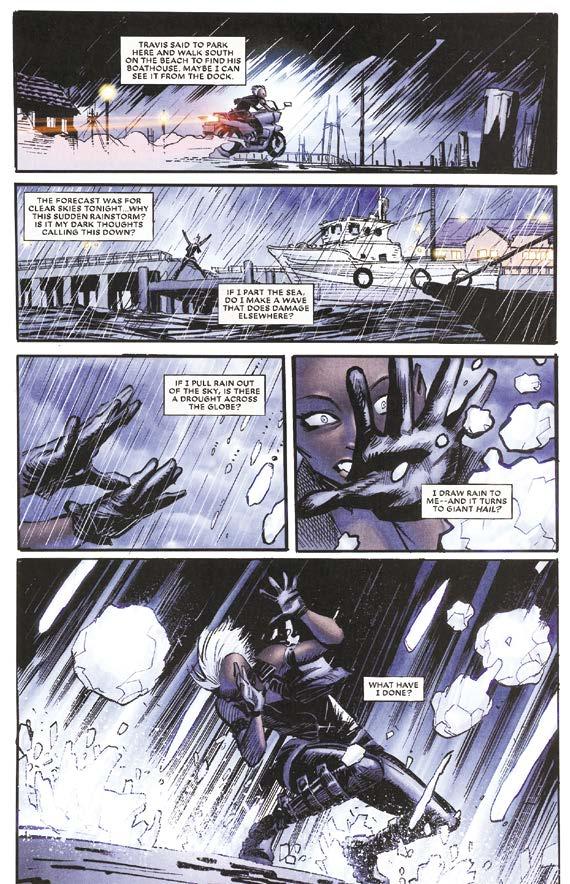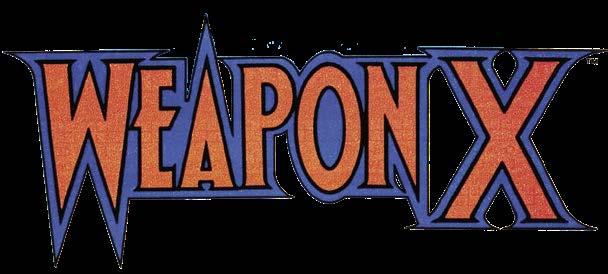
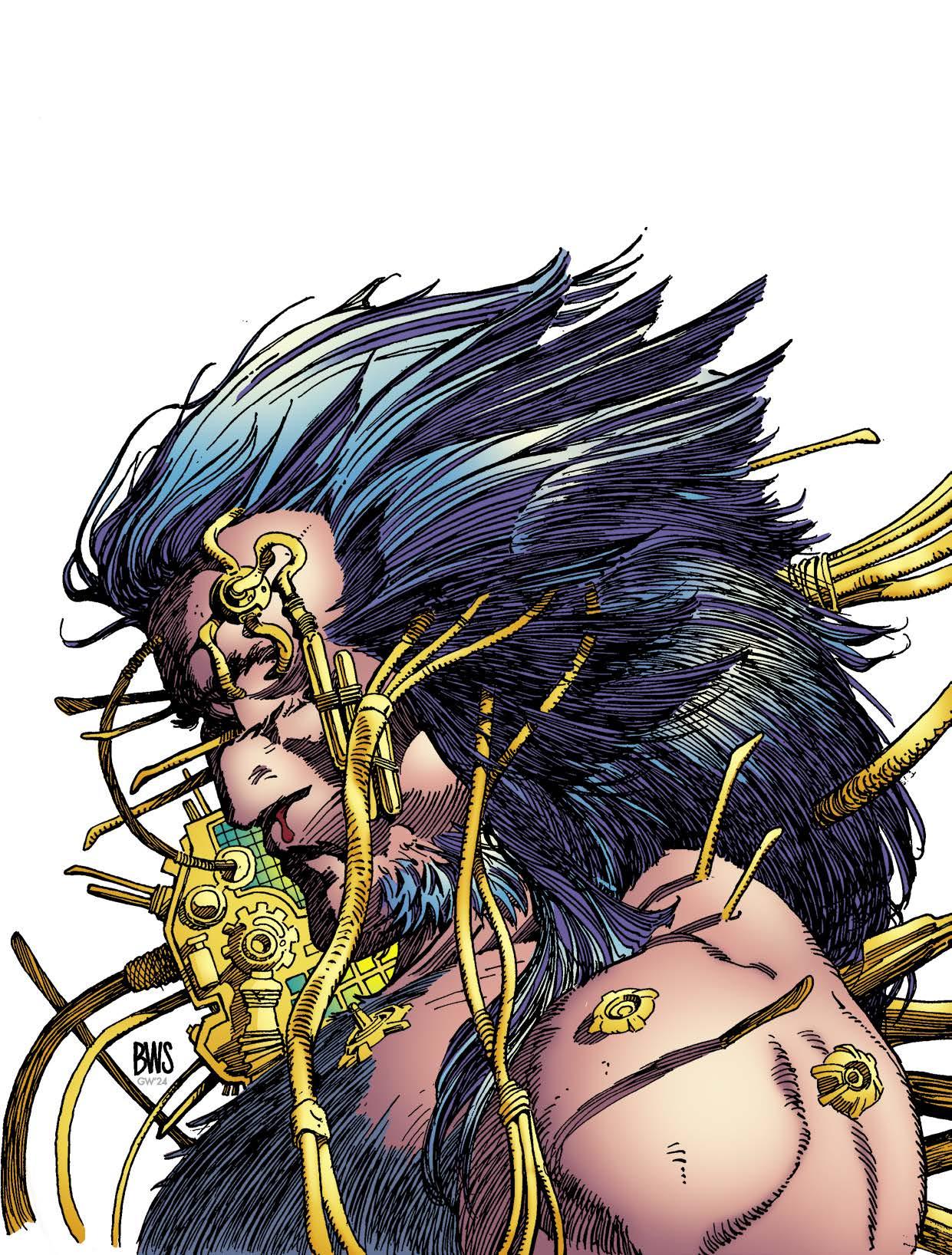
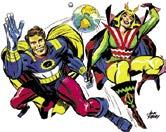
BACK ISSUE™ issue 161, September 2025 (ISSN 1932-6904) is published monthly (except Jan., March, May, and Nov.) by TwoMorrows Publishing, 10407
Raleigh,
USA. Phone: (919) 449-0344. Periodicals postage paid at Raleigh, NC. POSTMASTER: Send address changes to Back Issue, c/o TwoMorrows, 10407 Bedfordtown Drive, Raleigh, NC 27614. Michael Eury, Editor Emeritus. Roger Ash, Editor-In-Chief. John Morrow, Publisher. Editorial Office: BACK ISSUE, c/o Roger Ash, Editor, 2715 Birchwood Pass, Apt. 7, Cross Plains, WI 53528. Email: rogerash@ hotmail.com. Eight-issue subscriptions: $102 Economy US, $127.60 International, $39 Digital. Please send subscription orders and funds to TwoMorrows, NOT to the editorial office. Cover artwork by George Perez. TM & © DC Comics. All Rights Reserved. All editorial matter © TwoMorrows and Roger Ash , except Terry’s Toons © Terry Austin. Printed in China. FIRST PRINTING
by
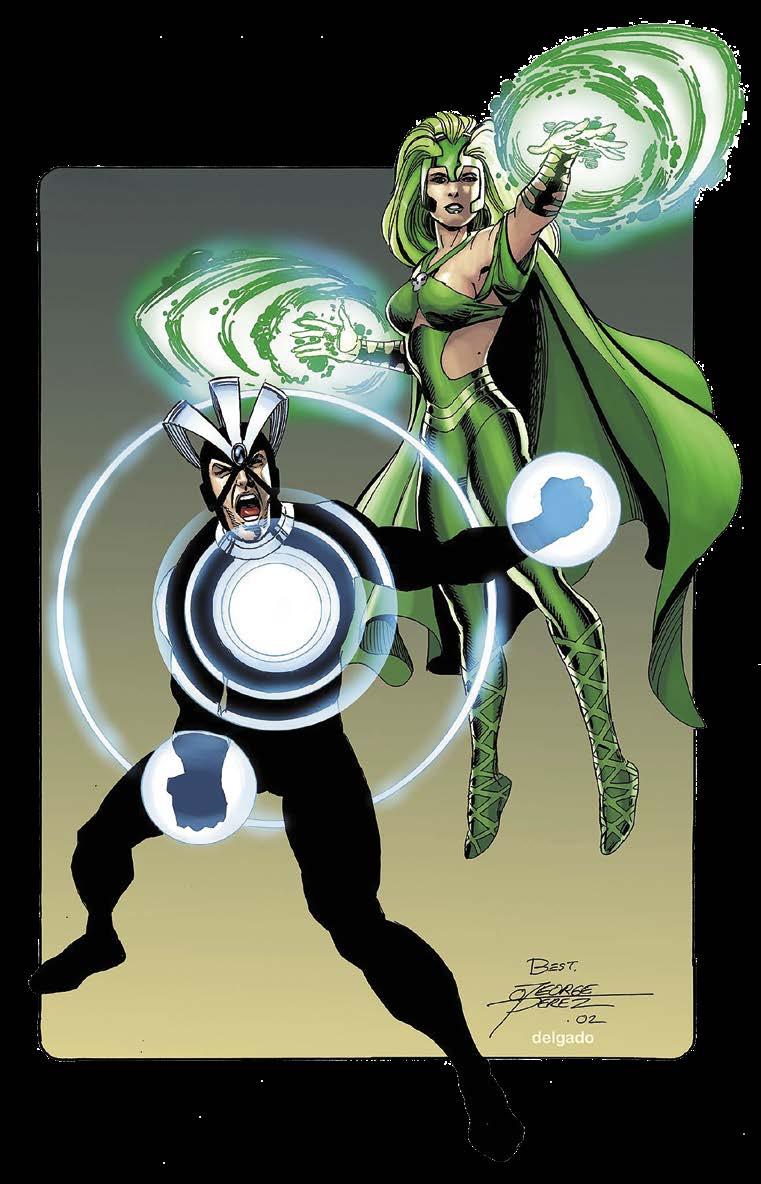
Many systems in the natural world endure a cyclical pattern: water, seasons, the moon, and even relationships. Some cycles can be interrupted, while others self-destruct, as in the cases of Romeo & Juliet, Echo & Narcissus, Bonnie & Clyde, and Alex Summers & Lorna Dane. Is a relationship worthwhile if the person you love the most is the source of your greatest heartbreak and trauma? Should you ever date the daughter of your brother’s archenemy?! The connection between Alex Summers and Lorna Dane is no exception to the universal dynamics of love, heartbreak, and reconciliation. Through the lens of the classic relationship cycle: honeymoon , doubt , adjustment, commitment , and acceptanc e, we can reflect on the many apexes and abysses endured by these two star-crossed lovers. Let’s review the frenetic mutant romance of Havok and Polaris!
HONEYMOON: SENTINELS, SAVAGE LAND, AND THE SHI’AR

The honeymoon phase can be identified as, “marking the earliest days of a relationship when laughter, lust and attraction are highest, the honeymoon phase can last for weeks, months or, in some cases, years” according to the Cleveland Clinic. Havok and Polaris’s first encounters demonstrated this period of courtship when they met in the late 1960s. After Stan Lee and Jack Kirby created the mutants of Xavier’s School for Gifted Youngsters, Arnold Drake and Jim Steranko briefly took over the comic. They introduced Lorna Dane into the fray in Uncanny X-Men #49 (Oct. 1968) and gave her powers in X-Men #50 (Nov. 1968). Next, Roy Thomas and Neal Adams began their memorable run in X-Men #56 ( May 1969 ) , sowing the first seeds of love between the pair. Bobby Drake, aka Iceman, was actually the first to court Lorna Dane, and became quite distraught when villainous Larry Trask captured her. In his first appearance wearing his iconic energy siphoning costume, Havok naively asks her beau, “Who’s the green-haired goddess racked out behind me?” in X-Men #58 (July 1969). In X-Men #61 (Oct. 1969), Lorna takes offense when Iceman refers to her as “my chick”—”I’m nobody’s property Bobby… except my own!” Former X-Men writer Roy Thomas said via email, “Havok had a head
Alex Summers and Lorna Dane stand united on George Perez’s striking variant cover to X-Men Hellfire Gala #1 (2023).
TM and © Marvel Characters, Inc.
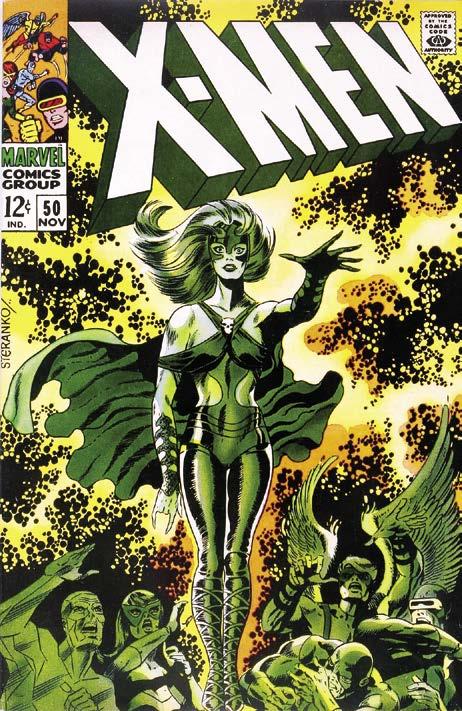
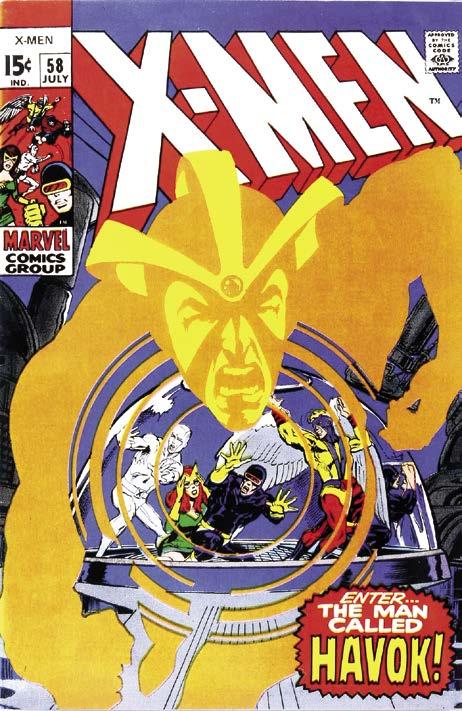
start because Alex Summers was created by Arnold Drake to be Cyclops’ brother—and then I made sure that he was a mutant (Arnold never told me if he intended him to be so or not); Neal Adams devised a truly fantastic costume for him. Polaris’ green hair doesn’t hurt, either.“ In an interview with Comic Book Artist (Winter 1999), Neal Adams noted this observation about Havok’s innovative design, “So if you speculate on the idea, you can say that the costume isn’t really a costume; it is a kind of energy container through which you can see the energy inside of his body.”
Soon Lorna is rescued from Trask due to Havok’s efforts, and later balks at the idea of being dropped off at her previous home, “The city isn’t home to me now…my place now…is with the X-Men!” in X-Men
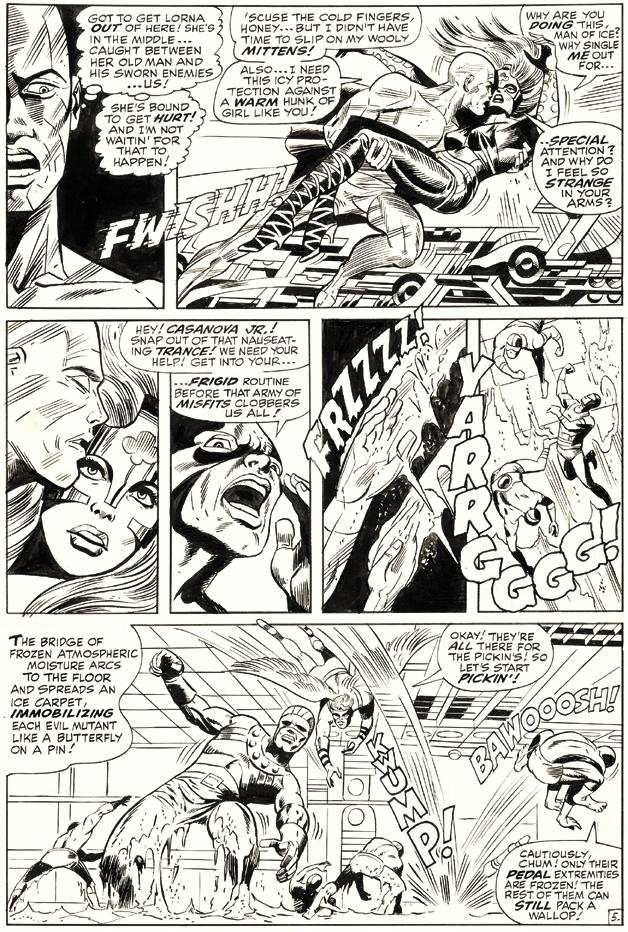
(top left) Lorna Dane looks mighty impressive on Jim Steranko’s cover to X-Men #50. (right) Be still my beating heart. Bobby Drake romances Lorna Dane on the original page from X-Men #51. Art by Jim Steranko and John Tartaglione. Original art scan courtesy of Heritage Auctions ( www.ha.com ). (bottom left) Neal Adams’ classic design for Havok’s costume takes center stage on the cover of X-Men #58.
TM and © Marvel Characters, Inc.
#60 (Sept. 1969). By the end of the Savage Land storyline, Havok and Polaris are on a path to becoming a true couple. Things come to a head in X-Men #66 (Mar. 1970) with Alex and Lorna staying behind on a mission to watch over a vulnerable Professor X with a jealous Iceman staying to keep tabs on them. Lorna soon quits the team in X-Men #94 (Aug. 1975). As the Giant Size X-Men #1 (May 1975) reboot introduced a fresh and more diverse cast, Polaris and Havok are rescued by these new characters from the living island Krakoa. In X-Men #97 (Feb. 1976), “My Brother, My Enemy,” Havok and Lorna are under the mental control of Shi’ar Agent, Eric the Red. It is also the first issue in which she goes by her new codename, Polaris. While living together and working on a geological survey, the couple is ambushed and mindwiped. Shortly thereafter they are used by Eric to attack their friends and eventually retreat when they are outnumbered. In X-Men #100 (Aug. 1976), robot sentinel versions of Havok and Polaris are used to attack the newer X-Men team. The actual couple is still under Eric’s control and appear via flashback in X-Men #104 and #105 (April and May 1977). A little over a year later, Havok and Lorna reappear in X-Men #119 (Mar. 1979) with their minds restored and all hatchets seemingly buried, with no explanation provided! Muir Island soon becomes both their base of operations and sanctuary. With Iceman no longer in the picture, this power couple will be on-and-off for the foreseeable future.
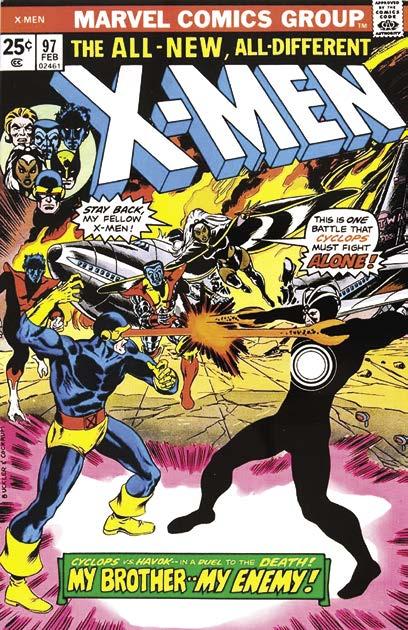
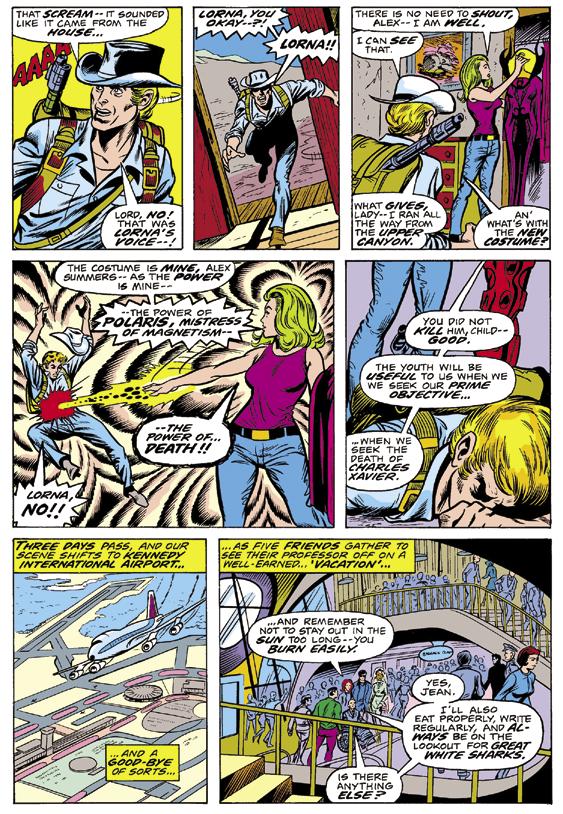
(top) Sibling rivalry on the cover of X-Men #97. (bottom left) Lorna takes the name Polaris, and blasts Alex for good measure, on this page from X-Men #97. (bottom right) Alex, Lorna, and more, welcome Jean Grey to Scotland in X-Men #119. Art by John Byrne and Terry Austin. Original art scan courtesy of Heritage Auctions (www.ha.com). TM and © Marvel Characters, Inc.
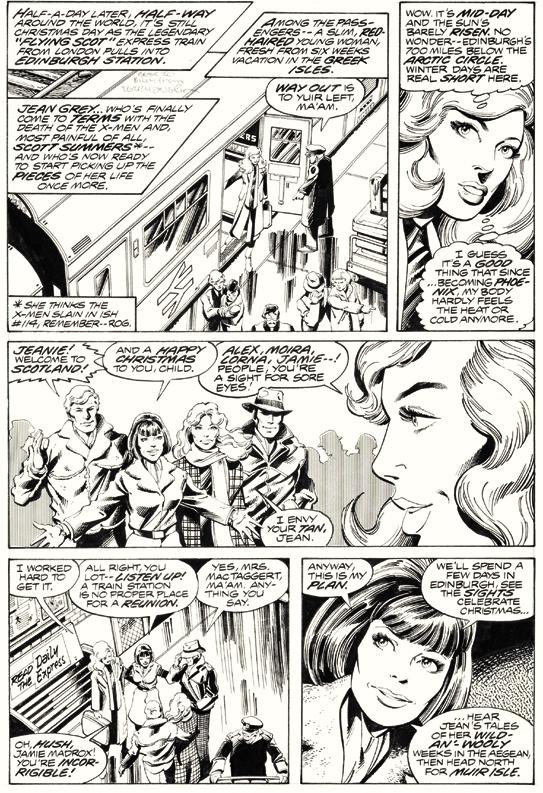
(left) Arcade on his throne in Marvel Team-Up #65. Readers don’t see his face until the following issue. (right) Arcade is revealed on the cover of Marvel Team-Up #66.
Claremont gives us a bit of background into his inspiration.
“It was Marvel Team-Up and I wanted/needed someone cool and different to go up against Spider-Man and Brian Braddock/ Captain Britain. I should qualify about any of those issues of Team-Up that I created in concert with John (Byrne) that it’s quite possible that creation was joint. It’s been a while and it’s hard to say which of us had the original idea. From my perspective, I wanted a villain who was just that: a villain. As utterly charming as he was with terrifyingly irredeemable.”
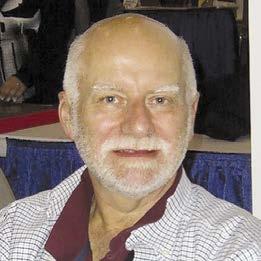
After the expected battle between Captain Britain and Spider-Man is resolved, the end of Marvel Team-Up #65 sees Arcade’s first move. Again, as unglamorously as one could imagine,
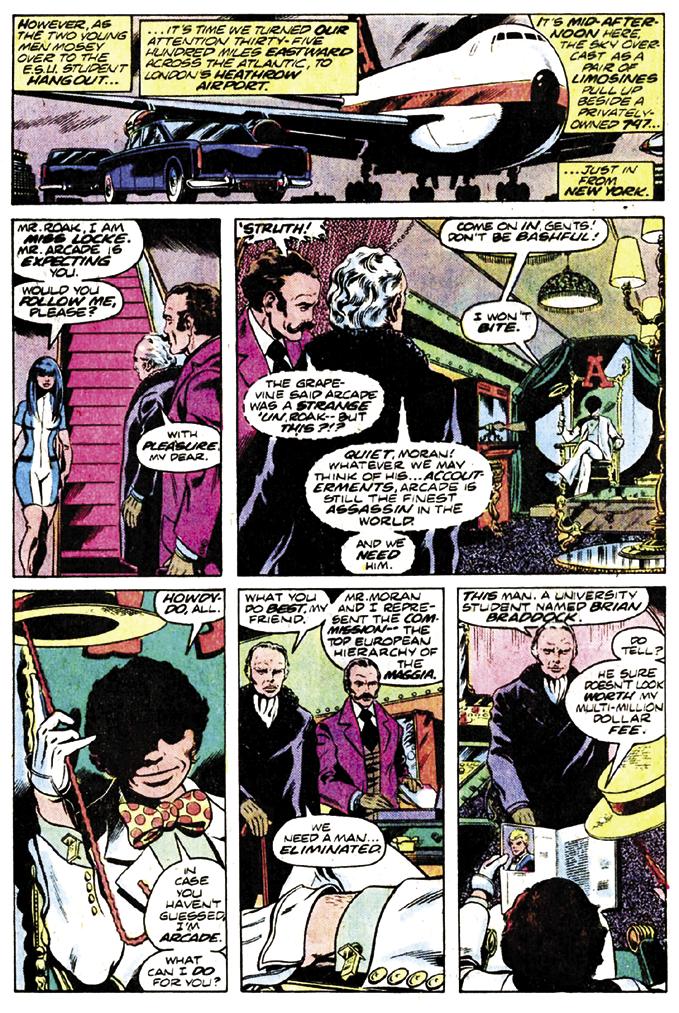
Arcade strikes both the heroes by surprise, using, of all things, a modified garbage truck to capture the heroes and render them unconscious to bring them to his modified amusement park known as Murderworld in issue #66. (Murder World is used interchangeably with Murderworld. For the sake of consistency, we’re going with one word as that is more common, unless used as two words in a story title or dialog. —Ed )
This is where we see Arcade in his power, the big reveal to the hints about this mysterious villain that Claremont has dropped in the previous issue. In other words, the payoff.
When we next see Arcade, he is accompanied by his henchmen, Ms. Locke and Mr. Chalmers, in an elaborate hi-tech computer control room, surrounded by lights and gizmos. Granted, for the time, all one needed was a backdrop of lights and buttons to represent a hi-tech computer room, and John Byrne does not fail to deliver in this respect. But gone are all the mundane trappings, the shadows that hid Arcade’s splashy outlook—now we see him in full villain regalia announcing his plot to kill both Captain Britain and Spider-Man for the Maggia. Encased in some sort of plastic ball, both heroes are shot into a gigantic pinball machine and Arcade’s modus operandi is revealed. Arcade’s first appearance doesn’t include any of the zany humor or psychological mania that readers would come to associate him with. We first see him as a serious assassin, technologically adept
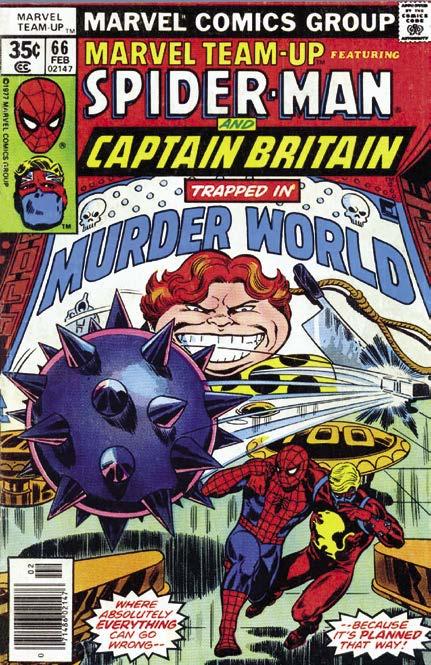
by Christopher Larochelle
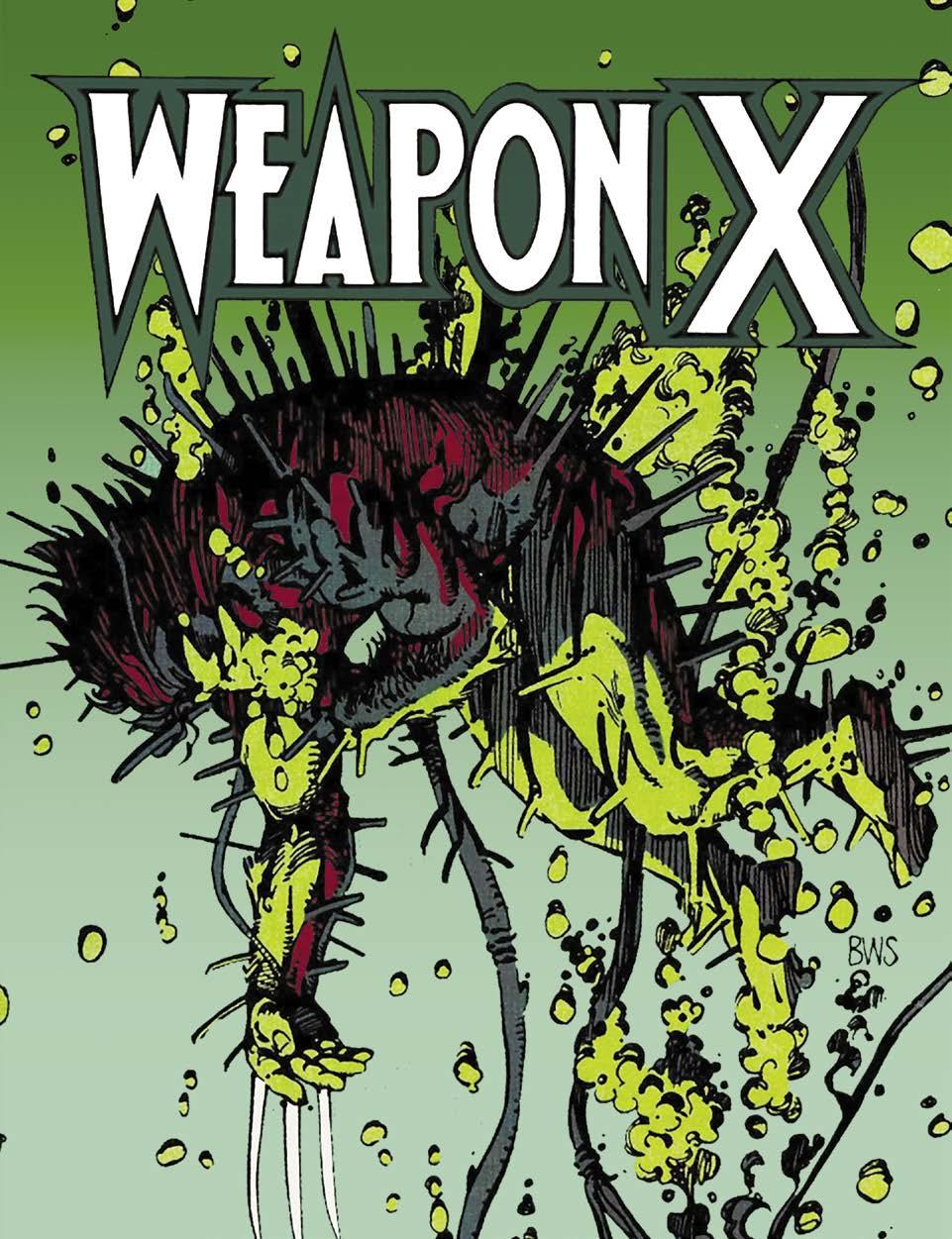
Logan could have killed us all… I met his eyes for a second…
Filled with hate and fury…
But I couldn’t tell if it was some animal bloodlust… Or horror at what we had done to him!
—Marvel Comics Presents #75 (1991)
Dr. Cornelius, one of a few characters providing narration throughout Barry Windsor-Smith’s masterful “Weapon X” story, says these words as things start to spiral out of control for the manipulative scientists aiming to exploit Wolverine. Trying to turn a person into a killing machine is risky
Logan floats in oblivion on Barry Windsor-Smith’s cover for Marvel Comics Presents #73.
business, and Cornelius clearly sees that things could hardly be more dangerous.
In 1991, “Weapon X” saw publication in eight-page installments within the pages of Marvel Comics Presents, an anthology book steered for much of its history by editor Terry Kavanagh. Storylines rotated in and out, featuring all kinds of characters (and for long stretches, always Wolverine). Barry WindsorSmith already had a great reputation as a comic artist, with beloved issues of Conan the Barbarian , Uncanny X-Men, and plenty more under his belt. Windsor-Smith’s art wasn’t seen often, but whenever he had a new project, it was always something for the reader to behold.
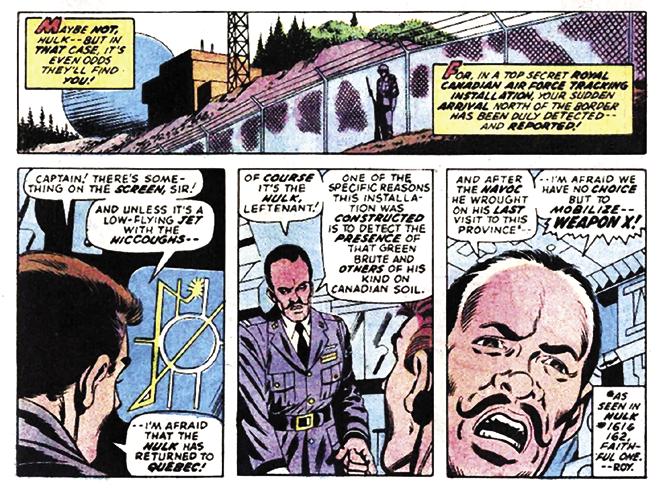
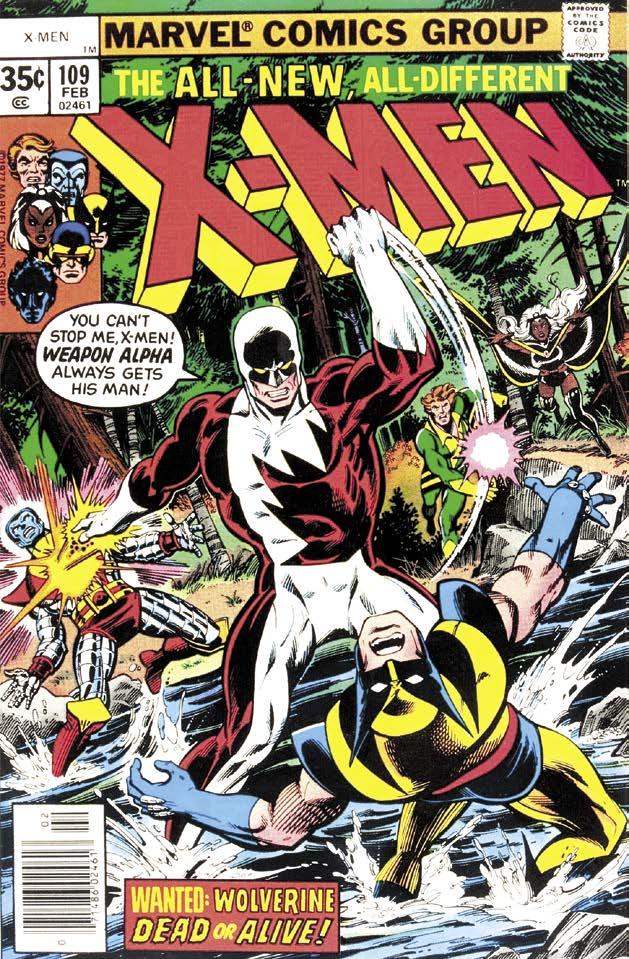
WHAT—ER—WHO IS WEAPON X?
Long before Barry Windsor-Smith’s story was printed, the entire concept of Weapon X was fairly mysterious (even though it’s connected to Wolverine’s character before readers even got to really know him!).
Famously, Wolverine debuted in the pages of The Incredible Hulk , being shown on-panel in exactly one frame of Hulk #180 (Oct. 1974) before a cover appearance and much more full-fledged debut in #181 (Nov. 1974). While the Hulk is on the run in Canada, an officer at a Royal Canadian Air Force installation is convinced that the Jade Giant has returned after only a brief time away (a caption from editor Roy Thomas notes that Hulk was last “visiting” Canada in Incredible Hulk #161 & 162).
“After the havoc he wrought on his last visit to this province—I’m afraid we have no choice but to mobilize—Weapon X!” declares the officer. Credit is due to writer (and Wolverine co-creator) Len Wein for drawing out the suspense as the issue plays out. Here’s the complete dialogue Wolverine speaks in this teaser debut: “All right, you freaks— just hold it! If you really want to tangle with someone—why not try your luck against—the Wolverine!”
The narration that wraps up The Incredible Hulk #180 pulls away the curtain: “Well, now you know what—er—who Weapon X is, faithful one. He’s a living, raging powerhouse who’s bound to knock you back on your emerald posterior.”
The Incredible Hulk #181 is when Wolverine’s capabilities in battle are really showcased. He’s a credible threat to both the Hulk and Wendigo, and as the fight carries on, a page of the story is dedicated to catching up with the military leaders discussing Weapon X. While they all wish they had some intelligence about how their operative was doing in his task to bring down the Hulk, there’s nothing that they’ve been able to learn. One man questions whether Wolverine was ready for the task at hand. His colleague rebukes him: “We wouldn’t have sent him if we didn’t think he was ready, Holderidge! The government has spent a great deal of time, effort, and money developing that mutant’s natural-born speed, strength, and savagery into the skills of a professional warrior—and despite the few kinks still remaining in his psychological makeup, I think we’ve done a pretty good job!”
Little else is learned about Weapon X when Wolverine next appears in Giant-Size X-Men #1 (May 1975) as Professor Charles Xavier works quickly to assemble an international team of mutants to rescue the first team he sent to the dangerous island of Krakoa. Xavier offers Wolverine “a chance to become a free agent,” and Wolverine seems quite eager to cut ties with the Canadian government. When the officer arranging the meeting between Xavier and Wolverine pipes up, mentioning the investment of time and money that Canada has poured into him, Wolverine gives some attitude back and uses one of his claws to slice the officer’s necktie in half. “Believe me, mister—you haven’t heard the last of
(top) Weapon X is hinted at on this page from Incredible Hulk #180. (bottom) Wolverine’s past comes back to haunt him in X-Men #109.
TM and © Marvel Characters, Inc.
ideas and a general concept, and I didn’t want to hang around and figure out a whole story. I kind of like not knowing what I’m going to do next. So once I talked to Terry and Tom DeFalco [Marvel’s editor-in-chief] and committed myself to doing the series, I took down three stories to show them. They didn’t even know I was doing it… I don’t like to go through this long process of presentations and ‘Is it all right if I draw this, please?’ I don’t care. If they didn’t like it —which was a bloody long shot; after all, it’s Logan, a major character—it wouldn’t have been a problem. But the upshot is that they did like it.”
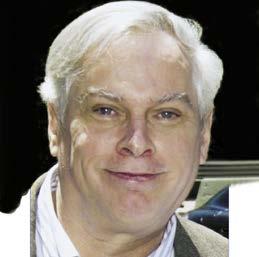
Kavanagh had plenty of reasons to worry about the project once more pages started coming into
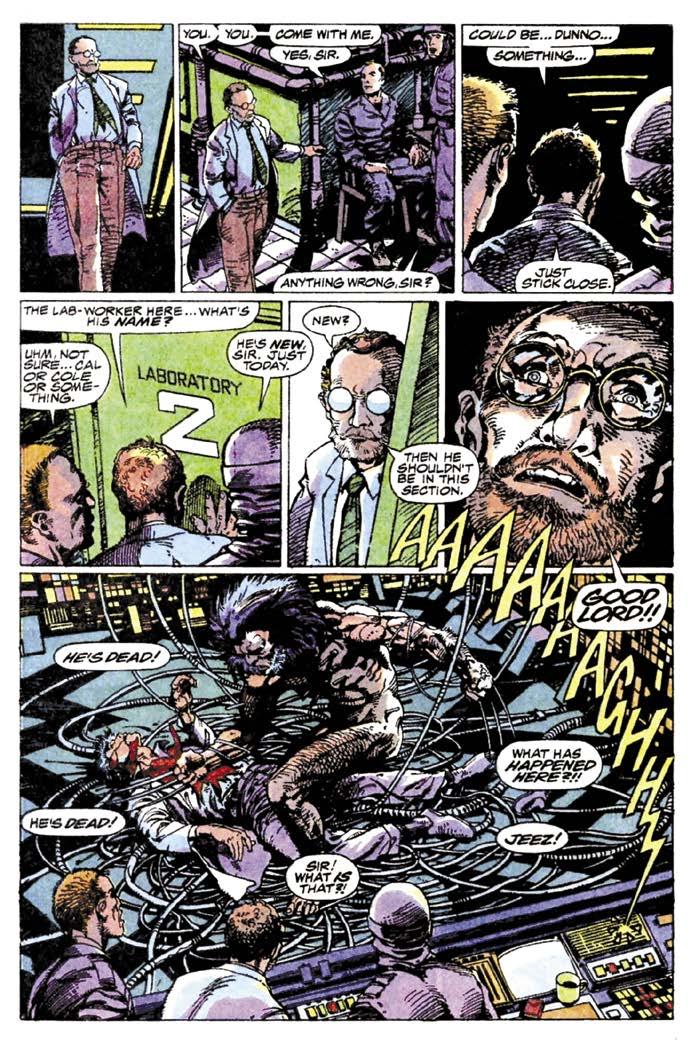
the Marvel offices: “The sales department was certainly interested any time the pages came in and I xeroxed them. Before we printed the first issue, I was called into Tom DeFalco’s office, and Carol Kalish [Marvel’s Direct Sales Manager] was there, and I was informed that Barry’s work was so good that we were going to do it in a hardcover graphic novel format, with better coloring and everything. I argued against the idea, saying that it wasn’t what I had promised Barry, and that he liked the format we were doing already, and that he had already started coloring some of it. I tried using business logic: ‘That doesn’t make any sense… we’d pay more money for work already done,’ and so on. I tried everything I could.
I’d recently been informed by Tom that I had to have a Wolverine feature in every issue. That was not the original intent for the book, but sales were always up when Wolverine was featured. I sat there and stewed for a little while, and then I walked into Tom’s office again. I asked for clarification, that the mandate was that I had to have a Wolverine story in every issue, but if the stories were too good, they would be printed in a different format…so the mandate was really that I had to do crappy Wolverine stories every issue. He stared at me for a minute, and he said in a very stern tone (after calling Carol back into the office) that the story would be printed in Marvel Comics Presents first, and then it would be reprinted in a graphic novel and recolored later. To his credit, Tom listened.”
Because of Terry Kavanagh’s convincing arguments, Tom DeFalco’s wisdom, and Barry
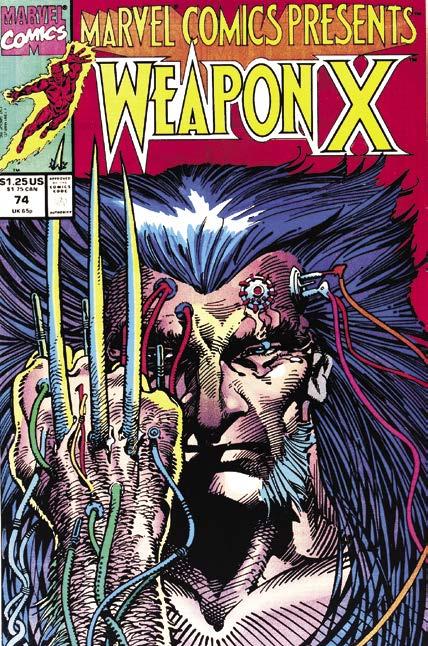
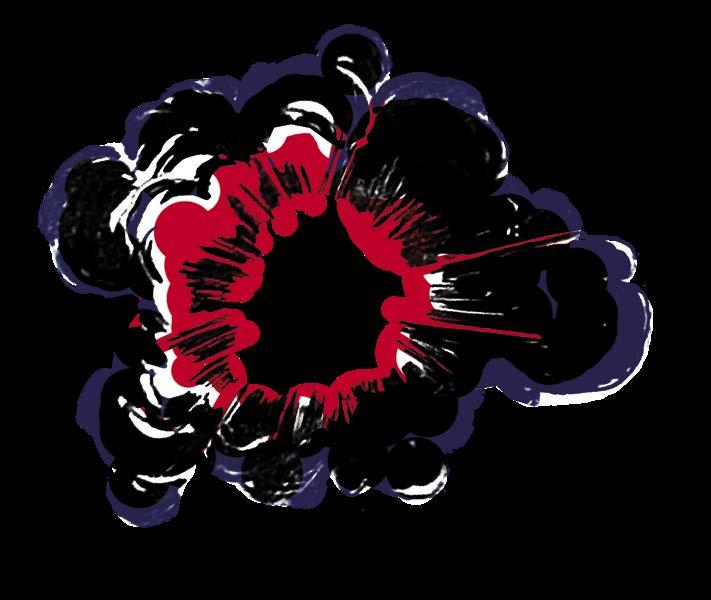
by Doug Zawisza
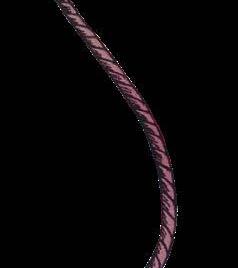
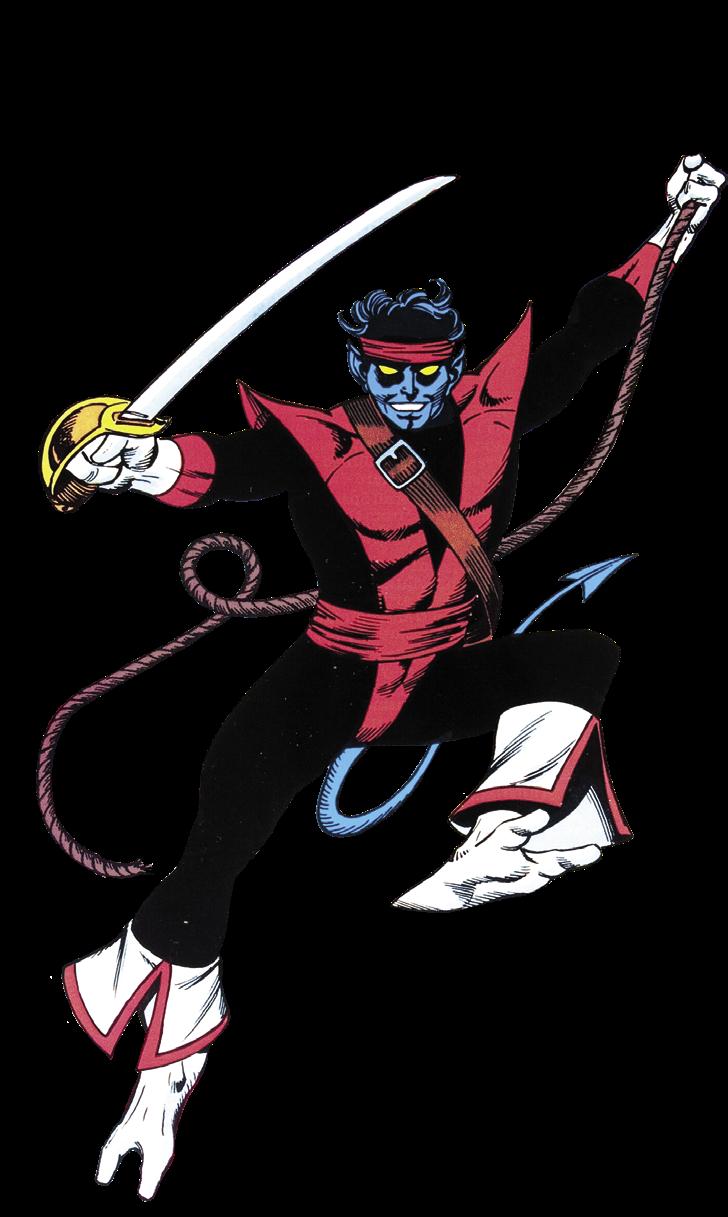
Every comic book reader who follows Marvel Comics’ merry mutants has a favorite member of the X-Men. Many fans (and even many fictitious denizens of the Marvel Comic Multiverse) consider Nightcrawler the best of the X. His upbeat, often self-deprecating, nature belies his dusky blue, demonic appearance, and genuinely invites all to get to know him better. What better way to get to know a character in the 1980s than to give them their own miniseries?
The checklist of Marvel comics found in issues cover dated November 1985 listed the first issue of the Nightcrawler limited series as containing, “The adventures of that world famous X-Man, as told by Dave Cockrum!” This series lives up to that billing, and goes far, far beyond it, giving Nightcrawler more than one world in which to find fame.
TO BAMF OR NOT TO BAMF?!
Written and drawn by the character’s co-creator, Dave Cockrum, the 1985 four-issue Nightcrawler limited series featuring the titular, Teutonic, teleporting, tailed X-Man opens with a bang. Well, a near-bang. Kurt Wagner, more famously known as the X-Man Nightcrawler, is practicing his evasive maneuvers during a “no-teleport” (or no-bamf) exercise in the Danger Room at Xavier’s School for Gifted Youngsters, leaping towards the reader with a menagerie of missiles rocketing after him.
Kurt Wagner’s first solo adventure in fourissue limited series form invites readers to join a colorfully magical, swashbuckling romp filled with sky-faring pirates, Boggies, beautiful princesses, and sorcerous sharkmen. In this series, Cockrum, serving as writer and artist, is able to uncork ideas that were likely swirling around his brain since before he ever proposed adding a character similar to Nightcrawler into the ranks of the Legion of Super-Heroes (a tale that has surely been addressed more completely elsewhere and elsewhen).
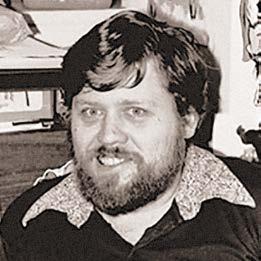
Colored by Paty Cockrum (Dave’s wife), lettered by Jim Novak, and edited by Ann Nocenti, this miniseries is one of the many mighty Marvel minis in the 1980s (See BACK ISSUE #132 for coverage of many others), but the first of many Nightcrawler solo adventure titles. Nocenti, in “The Mutant Report” feature of Marvel Age #31 (October 1985) describes the limited series as “A real romp. In the regular X-Men series, Nightcrawler has been going through some pretty heavy emotional trips.”
Parallel to this series, Secret Wars II was running, wherein Nightcrawler and the other X-Men are battling the Beyonder. A being with nigh-omnipotent
Dave Cockrum’s swashbuckling cover to Nightcrawler #1.
TM and © Marvel Characters, Inc.
power (and impressive ignorance to match), the Beyonder’s presence contributes to Kurt’s crisis of faith and purpose in the pages of Uncanny X-Men. As Nocenti continues, “Dave, in this limited series, gets him away from all that and shows how fun-loving he can be.”
While countless other X-Men have had solo adventures in and out of their own titles before and since, Nightcrawler most frequently (with the only exception being Nightcrawler’s drinking buddy, Wolverine) finds the spotlight. Thanks to the energy and adventure Cockrum and team pour into this limited series, it is quite obvious that everyone’s beloved, bombastic, bamfing Fuzzy Elf can go anywhere and do anything, always inviting readers to come along to join in the fun.
OH, GOSH!
From page 1 of Nightcrawler #1 (November 1985), Dave Cockrum thrusts us into the fantastic, leaving the mundane mudball of Earth behind for whatever happens on the pages of this series, free of continuity constraints and, oftentimes, even gravity. Kurt Wagner’s bamf-free test in the opening pages of “How Much is that Boggie in the Window?” features Nightcrawler’s non-teleportational gymnastic skills throughout a course filled with made-up machinery, whizzing weaponry, onomatopoeia-etic sound effects, flashbacks, and bold, dazzling colors.
The cast of characters to open the issue include Nightcrawler, his X-Men teammate Kitty Pryde (then bearing the moniker of Shadowcat), New Mutant Illyana Rasputin (Magik), and Kitty Pryde’s diminutive purple dragon companion, Lockheed. The cast expands, but only once Kurt Wagner is no longer on Earth.
In an era resplendent with thought bubbles, round-cornered flashback panels, explanatory text boxes, and multi-figure motion panels, writer/ artist Cockrum employs only the briefest of expository episodes, choosing instead to propel Herr Wagner into the awaiting adventures of this fabulous finite series.
Reflecting on the events of Nightcrawler’s first solo tale from Bizarre Adventures #27 (July 1981) titled “Show Me the Way to Go Home…”, which Cockrum penciled alongside Jo Duffy’s script, Nightcrawler has decided it is imperative to work out sans bamf - without teleporting. The aforementioned adventure stranded Nightcrawler at the Well at the Center of Time alongside fellow mutant teleporter, the villainous Vanisher. The Well at the Center of Time is a “bizarre metaphysical phenomenon that exists in all times and worlds and dimensions.” With their abilities put to the test, Nightcrawler and the Vanisher found themselves in a land that truly challenged and changed them.
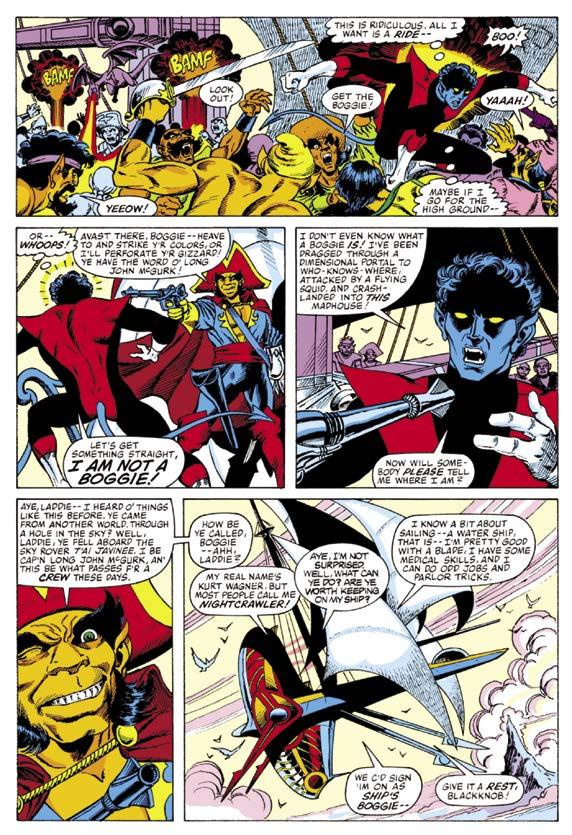
(left) Nightcrawler runs afoul of Long John McGurk. (right) Kurt makes the acquaintance of Jinjav Sabree.
TM and © Marvel Characters, Inc.
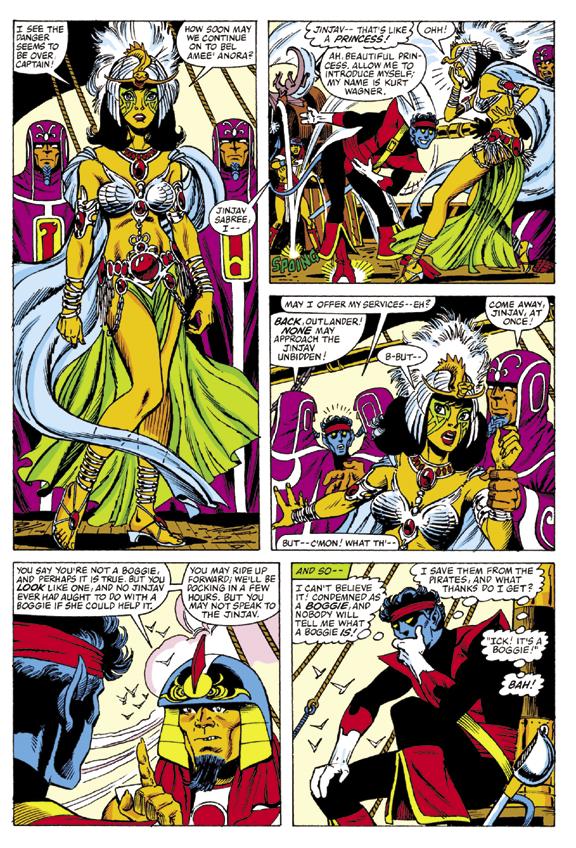
by Joseph Norton
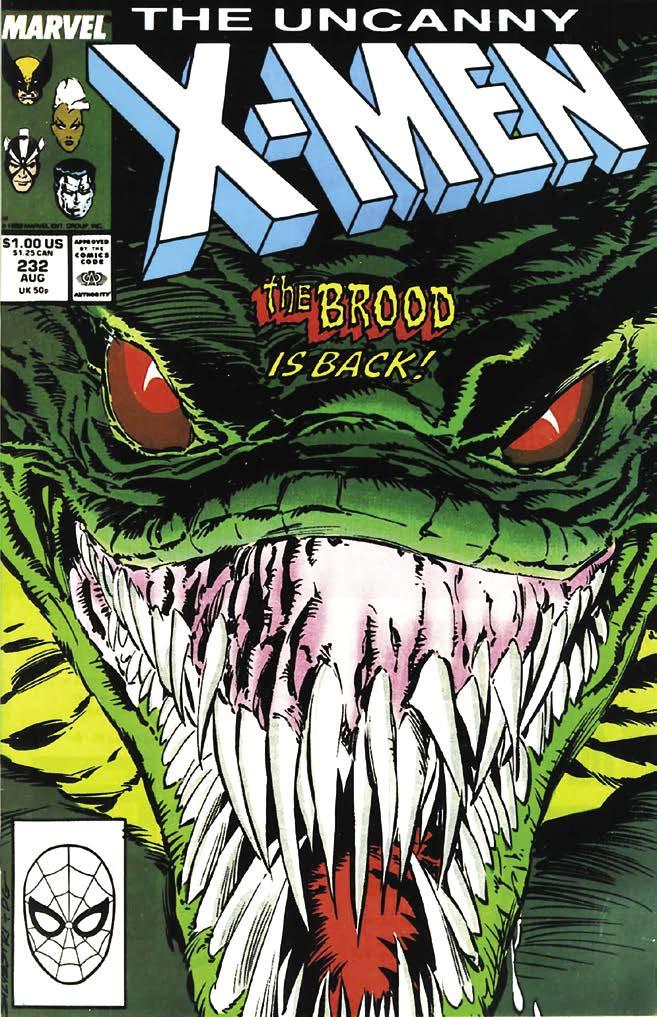
The X-Men’s greatest battles were always with themselves, with the mutant power growing inside them and the inner turmoil it created. That treatment of the characters was implemented in the grandiose early days of Stan Lee, when readers were treated to inner dialogues and more than the usual superhero angst. The X-Men were always more self loathing and filled with doubt than the typical hero thanks to the powers barely contained within the characters. Portrayed as a danger to each other and the world in general, writer Chris Claremont ‘s run tripled down on all of Lee’s framework, heavy on the drama. From his start in X-Men #94 (Aug.1975), Claremont’s version of the X-Men leaned in on all of the tension caused by the mutant gene and its effects on our heroes physically and psychologically. Claremont though did it with much more depth and grace. In Claremont’s run, no arch-nemesis captured the terror of your body betraying you, the forces within that you have absolutely no control over attacking you like the intergalactic alien threat, the Brood. They defeated the X-Men not by ripping out adamantium bones or neutralizing optic blasts. No, the Brood defeated the X-Men by transforming our heroes into one of the aliens, but not just to use them as faceless cannon fodder. They could take the X-Men’s powers and make them their own, utilizing them when they took over the X-Men completely. Further betrayal of the X-Men’s own bodies, this time their powers made them not just freaks of nature but vulnerable to an invasive attack, a hijack of their bodies. Again. No wonder why in such few appearances in the ‘80s, the Brood struck so much fear into the hearts of the X-Men and readers.
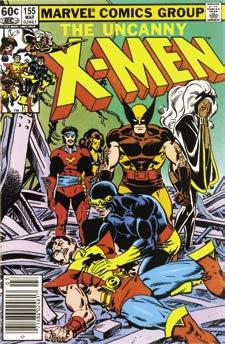
THE COMING OF THE BROOD
The Brood’s first appearance in Uncanny X-Men #155 (March 1982), the second part of a spectacular star-spanning story with The Shi’ar empire and the Starjammers, featured so much of what Claremont did well; father/son tension between Cyclops and Corsair, Storm coming into her own as a future leader of the X-Men, and a great new villain. Created by Claremont and X-Men artist extraordinaire Dave Cockrum, the Brood quickly captivated the
The terror of the Brood is made clear on the cover to Uncanny X-Men #232 by Marc Silvestri and Dan Green.
TM and © Marvel Characters, Inc.
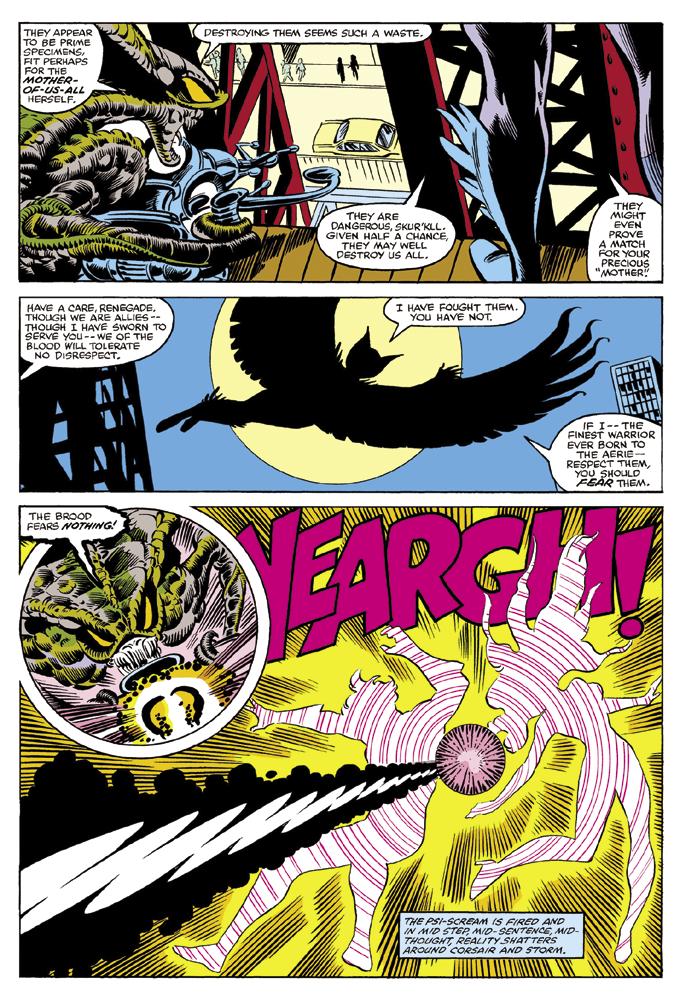
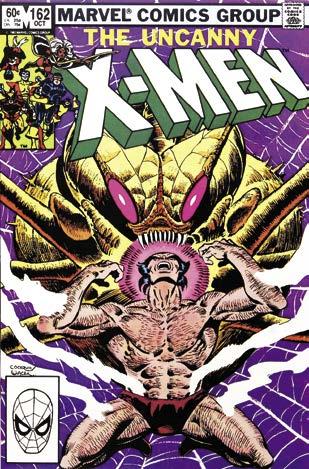
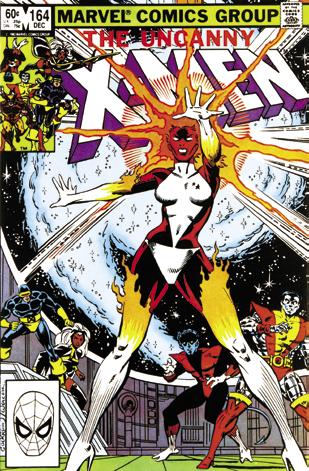
reader in a few panels. In a book titled X-Men Turn Thirty by Wizard, Cockrum said “We had Deathbird in this particular story and Chris [Claremont] had written into the plot ‘miscellaneous alien henchmen.’ So I had drawn Deathbird standing in this building under construction and I just drew the most horrible looking thing I could think of next to her.” From the start, there are glimpses of a greater threat behind the Brood, including their comment about sparing the X-Men for the “Mother-Of-Us-All.” Already more than “miscellaneous henchmen,” the reader is introduced to this theme, which would be seen fully fleshed out in future issues.
The next appearance of the Brood a few issues later in Uncanny X-Men #162 (Oct. 1982) is an intense and memorable tale. In arguably one of Wolverine’s greatest stories ever, told in Logan’s voiceover, the kind Claremont perfected in his run, the reader is dumped into the middle of a story, purposefully disorienting everyone. We see Logan being hunted by the Brood as he recounts
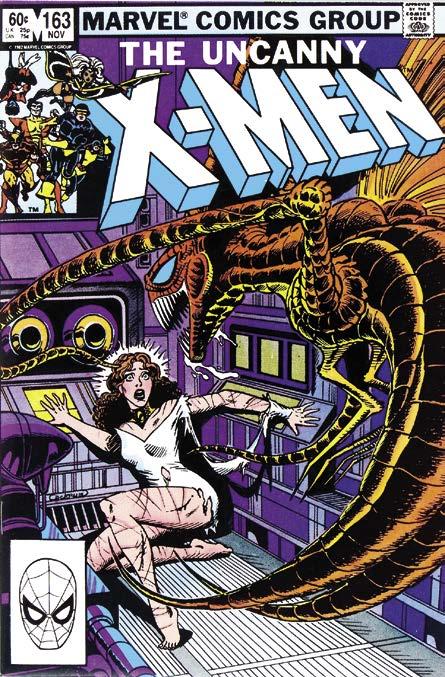
(top left) The first appearance of a Brood alien in Uncanny X-Men #155. (bottom left) The Brood make their first cover appearance on Uncanny X-Men #162. (bottom middle) Binary, a product of Brood experimentation, debuts in Uncanny X-Men #164. (right) Kitty is in dire peril on the cover of Uncanny X-Men #163. TM and © Marvel Characters, Inc. continued
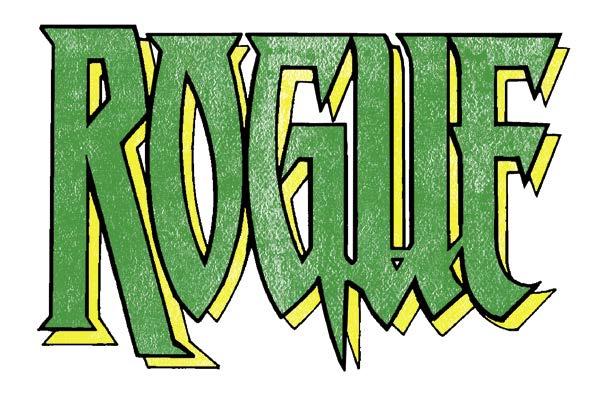
by Ed Lute
Rogue has long been one of the most beloved X-Men characters almost since her debut in the early 1980s. Many people, who may feel alienated, empathized with her plight of not being able to get physically close to anyone even within a team of outsiders. However, unlike some of her teammates who received miniseries (Wolverine, Gambit) or even serials in Marvel Comics Presents (Colossus, Cyclops), she wasn’t given her own solo feature until the mid-1990s and that was a sequel to a miniseries featuring another X-Man.
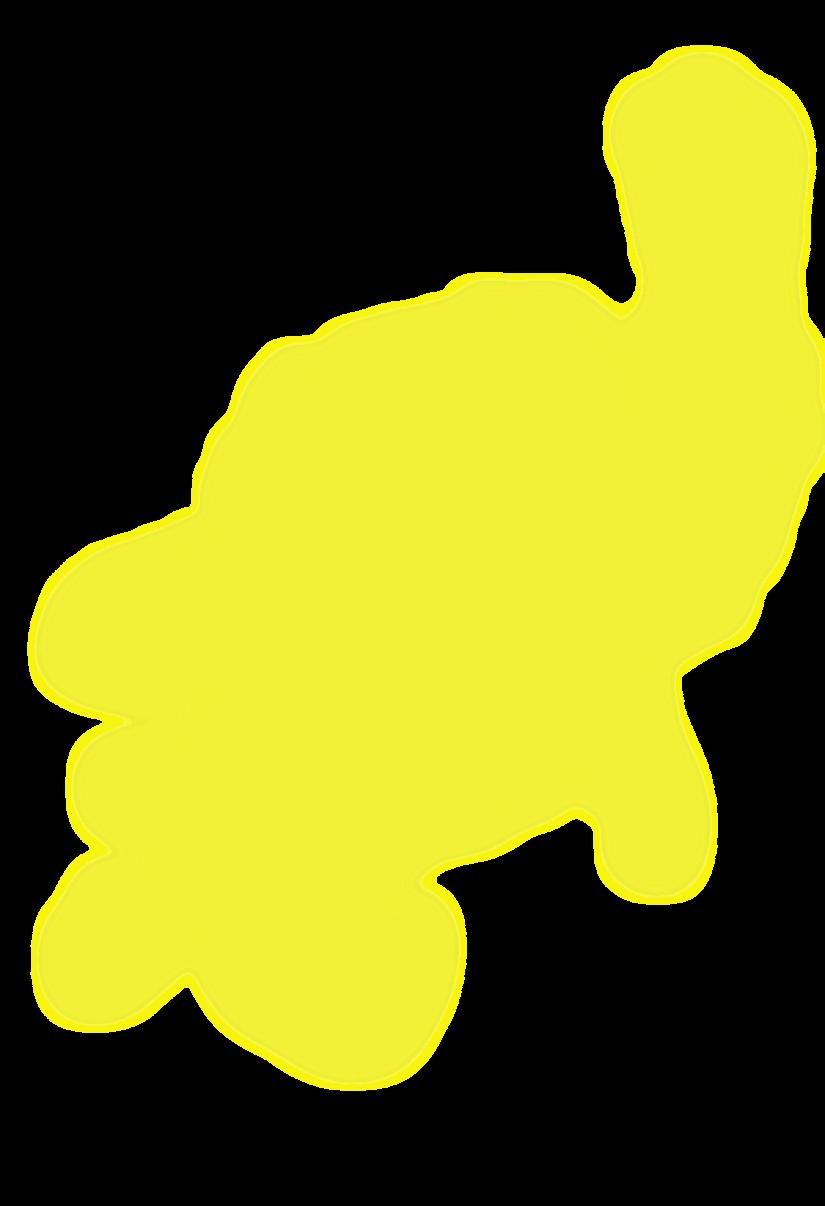
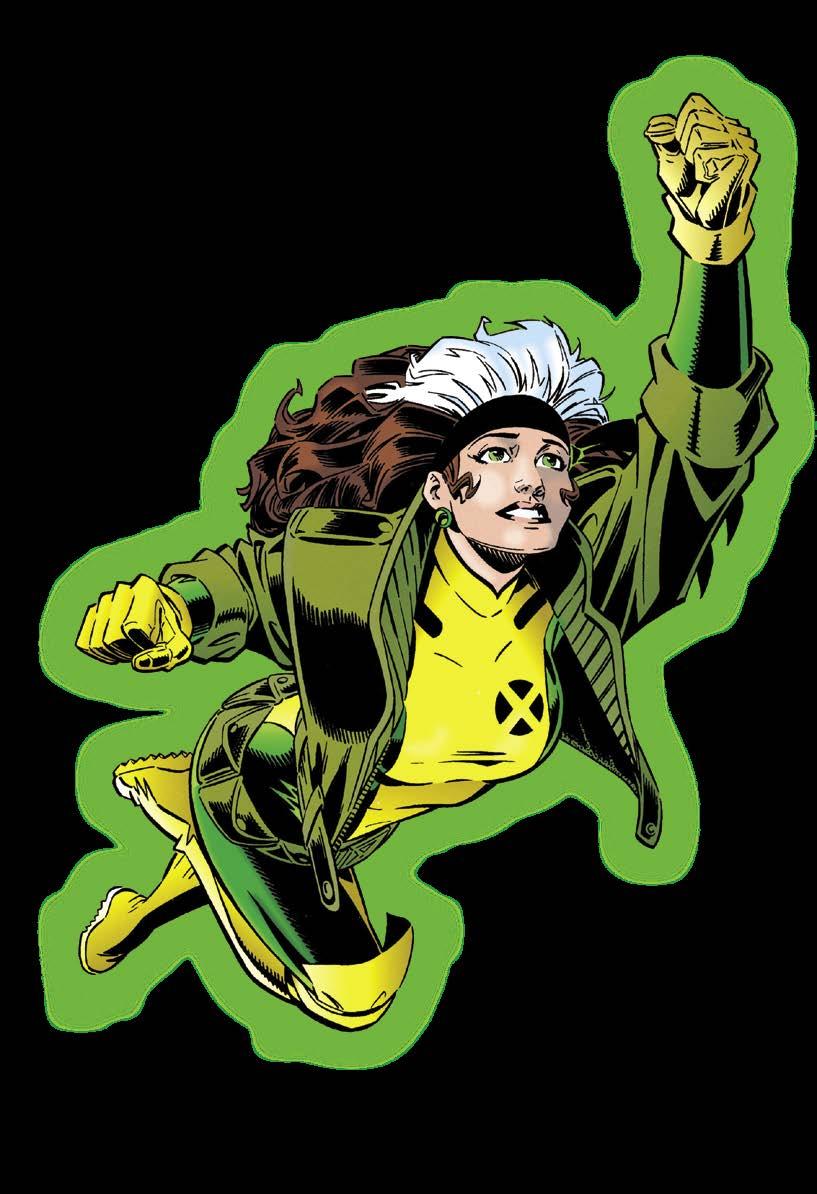
BACK ISSUE examines the Rogue miniseries, how it grew out of another miniseries featuring a different X-Men character as well as a throwaway line in an otherwise monumental issue of Uncanny X-Men , and how it helped to further develop Rogue.
ROGUE’S DEBUT
As with most members of the X-Men, Rogue had a mysterious history even before she became a member of the team. She debuted in the stone-cold classic Avengers Annual #10 (Oct. 1981) written by Chris Claremont with artwork by Michael Golden and Armando Gil. In the issue, the Brotherhood of Evil Mutants (Mystique, Avalanche, Blob, Destiny, and Pyro) wanted their newest member Rogue to take out Ms. Marvel (Carol Danvers). Unfortunately, Rogue did not know how to control her powers and in addition to absorbing Ms. Marvel’s powers, she also absorbed her personality as well. Rogue’s powers only temporarily gave her the powers of the person she came in contact with. However, due to her extended exposure to Ms. Marvel, the transfer was permanent. This remained the status quo for both characters for many years. Rogue was depicted as evil and without a conscience in this issue. However, that started to change in her next few appearances.
This storyline was supposed to appear in Ms. Marvel #25. Unfortunately, the title was canceled with issue #23 (Apr. 1979). Not one to let a good story go to waste, Claremont reused it to great effect in the annual. The original story by Claremont and artist Mike Vosburg finally saw print in Marvel Super-Heroes, Vol. 2, #10 (July 1992).
Rogue continued as a member of the Brotherhood in Rom #31-32 (June-July 1982) and the Sisterhood of Evil Mutants (now made up of only Mystique, Destiny, and Rogue) in Dazzler #2224 (Dec. 1982-Feb. 1983). It was during Rogue’s encounters with the space knight and the disco star that she began to question her relationship
Rogue finally gets to soar in her own miniseries, in Rogue #1. Wieringo/Austin cover. TM & © Marvel Characters, Inc.
with Mystique and Destiny, her own desire to do evil things, and what she was going through. Rogue couldn’t handle the pressure of having two conflicting personalities inside of her and her fellow evil mutants weren’t equipped, or didn’t seem to care, about her inability to deal with the problems she was going through.
So, in Uncanny X-Men #171 (July 1983), she turned to Professor Charles Xavier for help and asked to join the team. It was as a member of the X-Men that she learned to control her powers, became a force for good, and truly found a family. Although Professor X and the rest of the team did not trust her initially, she eventually earned their trust and respect.
Claremont had one reason in mind for making Rogue a member of the mutant team. He liked the character and wanted to write her. In a November 2016 interview with Jennifer M. Contino for Sequential Tart.com, Claremont discussed why Rogue became a member of the Merry Mutants, “Since there was virtually no chance of me writing The Avengers as well as Uncanny X-Men, and I wasn’t about to let Rogue, or Mystique—the one brilliantly designed and introduced by Michael Golden, the other by Dave Cockrum—be handled by anyone else. Which is actually what happened, briefly, in, I believe, Dazzler.” Claremont brought her to the X-Men where he developed her character over the years. She was featured in many of the X-Men’s biggest crossover events including “Mutant Massacre,” “Fall of the Mutants,” and “Inferno.” She went from a reluctant villain to a heroic member of the mutant team. However, her past continued to be shrouded in mystery.
GAMBIT MINISERIES
While this article examines the Rogue miniseries, we need to go back a year and first examine the Gambit miniseries. Don’t worry, true believers, we will get to the Rogue miniseries!
Writer Howard Mackie tells BACK ISSUE , “I’m sure there was some sexism involved with Gambit getting a miniseries before Rogue (laughs). No, there’s actually a whole story behind the Gambit miniseries that I remember well.”
“I made my rep. writing comics primarily with Ghost Rider,” Mackie continues, “That was my first big hit and then I did Spider-Man stuff. I had the success of the Ghost Rider series and then we did this one-shot called Hearts of Darkness. Let’s put Ghost Rider, Wolverine, and Punisher (three of the top characters in the industry) in one book and we’ll get John Romita Jr. to draw it. It was literally a license to print money. (Laughs) So I did that and it sold as well and even better than they hoped it would. The numbers were through the roof.
“It was a huge hit. I remember I came up to the Marvel offices because I was off-staff at that point.
(top left) Rogue debuts in Avengers Annual #10, with Michael Golden art. The cover gives no indication how important she would become. (bottom) Rogue takes down Captain America with ease in Avengers Annual #10. (top right) Rogue takes on a Spaceknight in ROM #31. ROM TM & © Hasbro Inc. Other characters TM & © Marvel Characters, Inc.
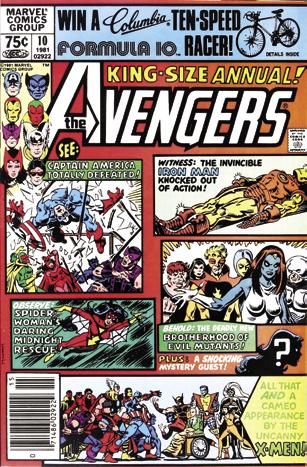
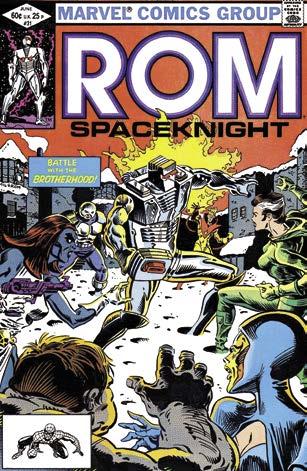
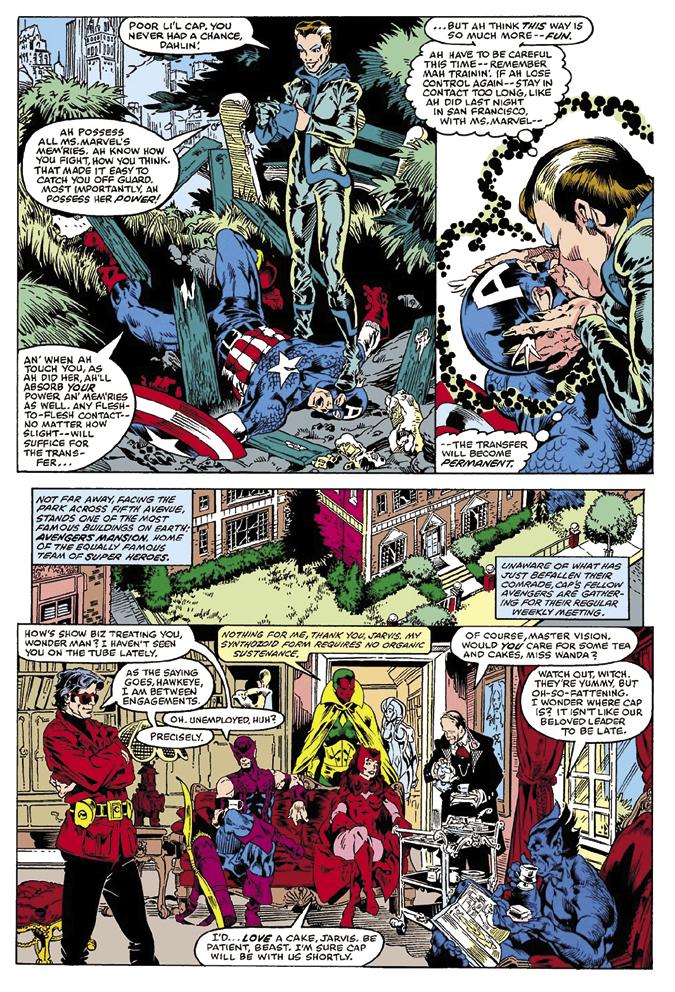
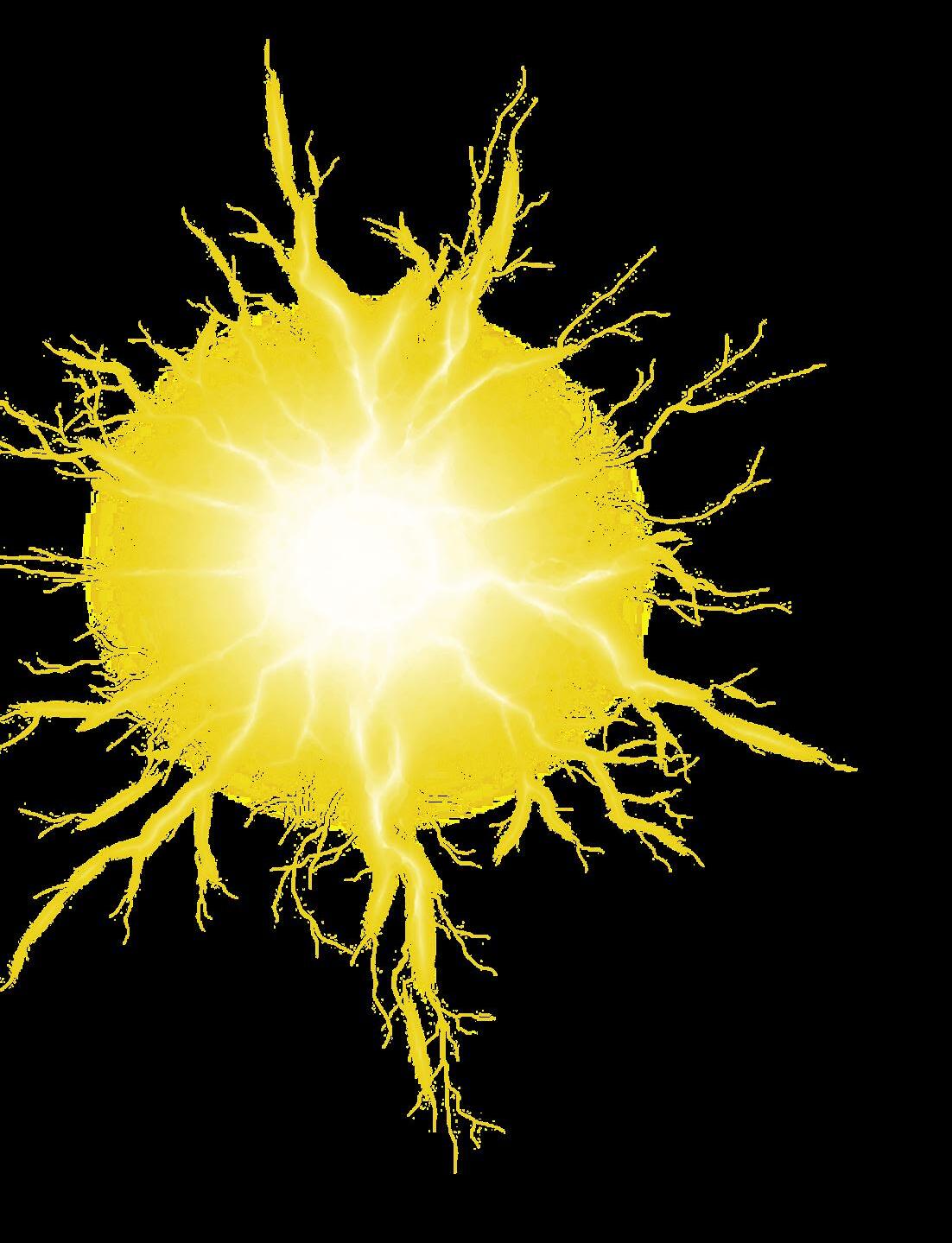
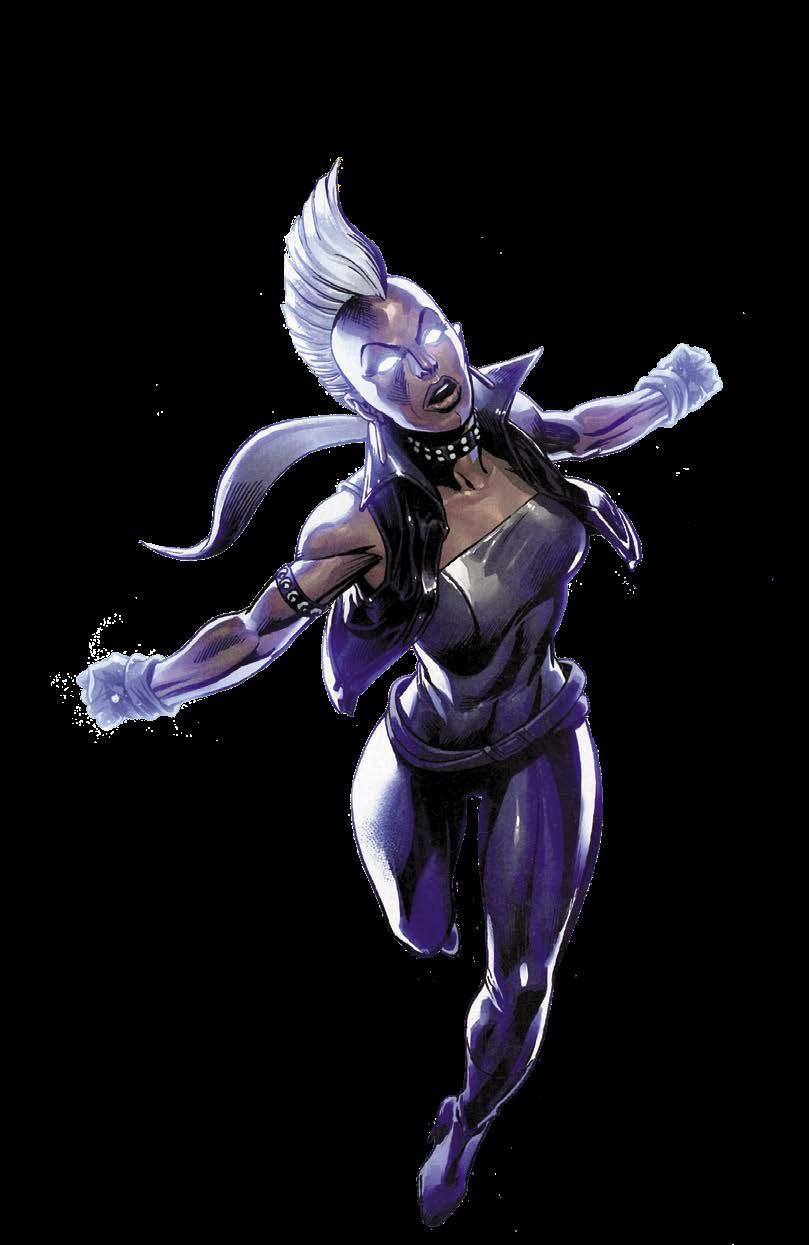
In recent years at Marvel, an impressive number of X-Men -related titles have been published set within the classic 1980s period. One highlight of these nostalgia-fueled offerings is Ann Nocenti’s 2023 Storm miniseries. With this five-issue epic, which fits organically around the time of Uncanny X-Men #176 (Dec. 1983), Ann has returned to the turbulent time of punk-Storm, who is dealing with assuming the leadership vacuum of the X-Men left by Cyclops; Kitty Pryde, who is upset by her friend and mentor’s dramatic change of appearance; and Rogue, who is learning how to be trusted by the team. In the desire to learn more about how Ann has so seamlessly recreated—and built upon—
Uncanny X-Men mythos of 1983, we shared the following rewarding conversation about her layered writing on Storm…
Ann, what do you love about the
I was the editor of the Uncanny first, and I had spent a year working under Louise Simonson, a super-talented editor. She was able to listen to Chris Claremont, who would spout a thousand ideas a minute. We’d usually take him to lunch. He liked being fed, and we would go out, and I would sit and just watch. Weezie would just sort of stay quiet, and then she would brighten up and zoom in when he had a great idea. I just watched her like a sponge, absorbed her method, so working with Chris was then really easy because he’s insanely creative. He has a million ideas, and you just have to pick out the best ones. Then, you just send him back home, and Chris comes up with all these storylines. A lot of it is like this with team books, which is like singing in rounds. You want to have an overarching narrative, which could be, say, “Who’s the team leader? How good of a job are they doing? Are they getting sick of it? Do they want to go off somewhere?” miniseries, it was launched by the idea that Scott Summers, Cyclops, who had been devastated by the death of Phoenix, had left to go get married to her clone, Madelyne Pryor, which was a real drama. In other words, with the X-Men, you’re a team. It’s like working for the military or something. You’re going out on excursions, but you’re probably getting PTSD, which we don’t really talk about in the comics business because every month you need a new adventure. However, at some point, you get overwhelmed, just like any soldier coming back from war, and so Scott had been team leader, but he’s now got PTSD from war. miniseries, the dynamics at the time were that they also had been fighting Mystique—and what were they called again? The
Ororo flies high in Storm #1, cover by Alan Davis and Alejandro Sánchez. Scans for this article provided by Amanda Powers.
TM & © Marvel Characters, Inc.
Brotherhood of Evil Mutants, right? Not that I know why you would call yourself evil, since most evil never admits it’s evil. Anyway, Cyclops leaves, so who’s going to lead the X-Men? Wolverine has never wanted to be the leader. Nightcrawler is German, and Colossus is Russian, so they weren’t used to the culture or the language, and Kitty’s too young. Storm then steps up, and she had just beaten Callisto and the Morlocks, and so Mark Basso, the editor of Storm, sent me a couple issues of the X-Men when this event had happened.
What I love about the X-Men—to answer your question—is that it’s a giant soap opera with personal dynamics and always-empowered women, because Chris was really influenced, I think, by his mother and an aunt that he had, and he was really interested in empowering the female characters and in having an ethnically diverse team. At this point, it’s sort of very boring to even say it, but the Uncanny X-Men always represented diversity and outsiders and addressed the issues of intolerance, racism, and all that stuff.
POWERS: You’ve wonderfully answered my question, Ann! Can you please elaborate upon how the Storm miniseries originated?
NOCENTI: The idea was to take two issues of Chris’s run and do a story that would happen between the issues, so I thought, “What if you were suddenly the boss of all your friends? Would your friends like that?” I know my friends wouldn’t obey my orders if I were suddenly the boss of them. They would try to oust me. That’s what Storm had to do. She had a sort of mother-daughter relationship with Kitty, who is furious that there’s now this “boss-distance” between them and that Ororo went out and got her hair cut in a Mohawk and now dresses in leathers.
There’s that famous moment in Uncanny X-Men #173 (Sept. 1983) that Chris wrote where Kitty is just furious that Ororo came home one day and had shaved her head. That was Kitty’s kind of crux, as she feels like saying to Storm, “I thought we were close enough that if you’re going to get a Mohawk and dress in leathers, you’d at least take me shopping with you or talk about it!” We had those dynamics, and then there’s Rogue, who had been in the Brotherhood of Evil Mutants and is suddenly invited to join the X-Men. Now that’s another thing: What if you had a worst enemy, and suddenly your friend or partner invited them to live with you?
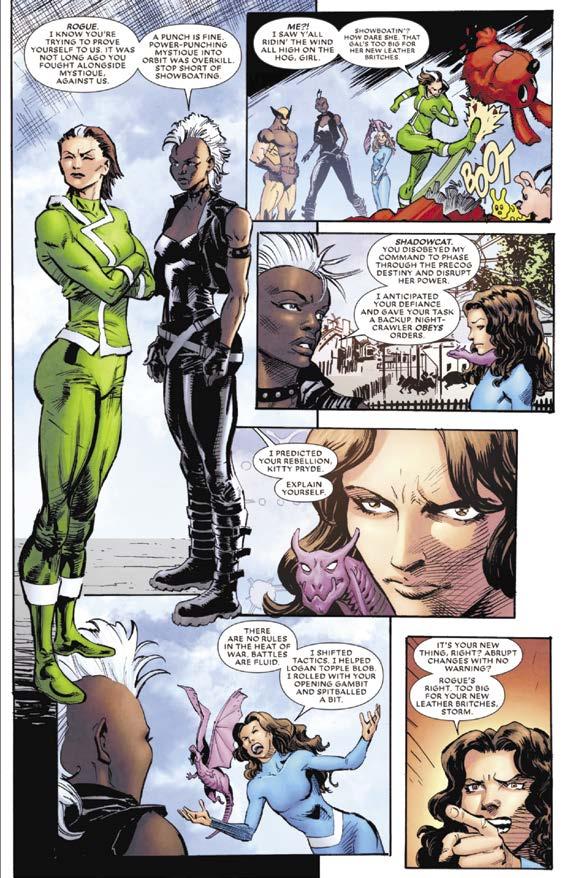
IF YOU ENJOYED THIS PREVIEW, CLICK THE LINK TO ORDER THIS ISSUE IN PRINT OR DIGITAL FORMAT!
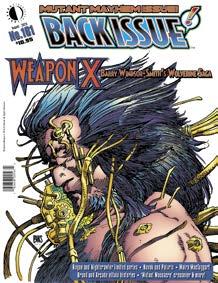
BACK ISSUE #161
MUTANT MAYHEM ISSUE! BARRY WINDSOR-SMITH’s Weapon X Wolverine, the romance of Havok and Polaris, Rogue and Nightcrawler limited series, Brood and Arcade villain histories, “Mutant Massacre” crossover, and more! With JON BOGDANOVE, JOHN BYRNE, CHRIS CLAREMONT, DAVE COCKRUM, LOUISE SIMONSON, MIKE WIERINGO, and more! WINDSOR-SMITH cover.
(84-page FULL-COLOR magazine) $10.95 (Digital Edition) $4.99 https://twomorrows.com/index.php?main_page=product_info&cPath=133&products_id=1825
The drama for the miniseries is set on these two pages. Storm has relationship issues with Rogue and Kitty and isn’t sure she can trust her powers.
